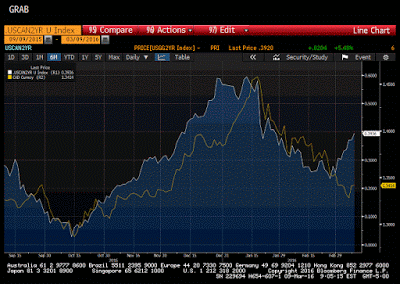Summary:
The Canadian dollar appears vulnerable. It remains firm while the US two-year premium over Canada has risen sharply. Like others, we do not expect the Bank of Canada to cut rates today and are looking past it. This Great Graphic was composed on Bloomberg. It shows the 2-year spread (white line) and the US dollar against the Canadian dollar (yellow line). We use two different scales, but the point is not so much how precise they have tracked each other. With two different scales that is misleading. However, they do in fact trend together. In mid-October, the premium bottomed a day before the US dollar did. The trend that began then carried into the 2016. The 2--year premium peaked on January 13 just below 60 bp. The US dollar peaked on January 19 near CAD1.4580 on a closing basis. Since mid-January the US dollar trended lower, falling to almost CAD1.3260 at the start of this week. The US 2-year premium fell to nearly 23 bp on February 25. Since then the premium has risen back to almost 40 bp today. The US dollar is off its low against the Canadian dollar, but it remains in the trough. Technical indicators, like the RSI, have stabilized and the MACD is about to cross higher. Of course, interest rate differentials are not the only driver. Oil prices are firm and that lends support to the Canadian dollar.
Topics:
Marc Chandler considers the following as important: FX Trends, Great Graphic
This could be interesting, too:
The Canadian dollar appears vulnerable. It remains firm while the US two-year premium over Canada has risen sharply. Like others, we do not expect the Bank of Canada to cut rates today and are looking past it. This Great Graphic was composed on Bloomberg. It shows the 2-year spread (white line) and the US dollar against the Canadian dollar (yellow line). We use two different scales, but the point is not so much how precise they have tracked each other. With two different scales that is misleading. However, they do in fact trend together. In mid-October, the premium bottomed a day before the US dollar did. The trend that began then carried into the 2016. The 2--year premium peaked on January 13 just below 60 bp. The US dollar peaked on January 19 near CAD1.4580 on a closing basis. Since mid-January the US dollar trended lower, falling to almost CAD1.3260 at the start of this week. The US 2-year premium fell to nearly 23 bp on February 25. Since then the premium has risen back to almost 40 bp today. The US dollar is off its low against the Canadian dollar, but it remains in the trough. Technical indicators, like the RSI, have stabilized and the MACD is about to cross higher. Of course, interest rate differentials are not the only driver. Oil prices are firm and that lends support to the Canadian dollar.
Topics:
Marc Chandler considers the following as important: FX Trends, Great Graphic
This could be interesting, too:
Marc Chandler writes Great Graphic: Views Distill to Short Sterling Long Yen Opportunity
Marc Chandler writes Great Graphic: Euro’s (OECD) PPP
Marc Chandler writes Great Graphic: The Dollar Index Climbs a Wall of Worry
Marc Chandler writes Great Graphic: Weekly Jobless Claims and the S&P 500
The Canadian dollar appears vulnerable. It remains firm while the US two-year premium over Canada has risen sharply. Like others, we do not expect the Bank of Canada to cut rates today and are looking past it.
This Great Graphic was composed on Bloomberg. It shows the 2-year spread (white line) and the US dollar against the Canadian dollar (yellow line). We use two different scales, but the point is not so much how precise they have tracked each other. With two different scales that is misleading.
However, they do in fact trend together. In mid-October, the premium bottomed a day before the US dollar did. The trend that began then carried into the 2016. The 2--year premium peaked on January 13 just below 60 bp. The US dollar peaked on January 19 near CAD1.4580 on a closing basis.
Since mid-January the US dollar trended lower, falling to almost CAD1.3260 at the start of this week. The US 2-year premium fell to nearly 23 bp on February 25. Since then the premium has risen back to almost 40 bp today. The US dollar is off its low against the Canadian dollar, but it remains in the trough. Technical indicators, like the RSI, have stabilized and the MACD is about to cross higher.
Of course, interest rate differentials are not the only driver. Oil prices are firm and that lends support to the Canadian dollar. Healthier risk appetites, reflected in rising equities, is tends to be supportive of the Canadian dollar. Also, Canada reports February employment data on Friday. The consensus calls for a 10k increase in employment after a 5.7k decline in January, which reflected a loss of more part-time jobs, but a 5.6 rise in full-time positions. Nevertheless, we suspect the two-year rate differential embodies the contrasting macroeconomic considerations. A move above CAD1.35 lends credence to our suspicions of the Canadian dollar's vulnerability.

